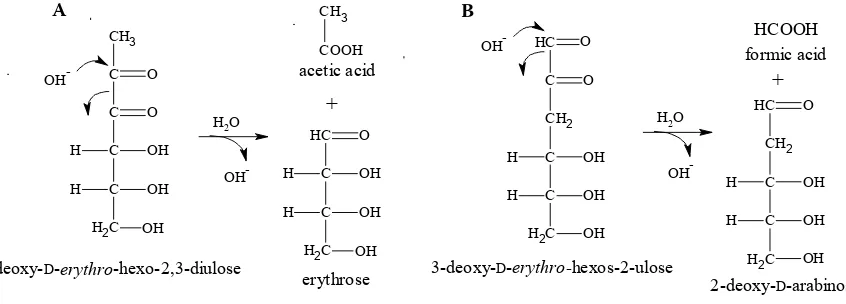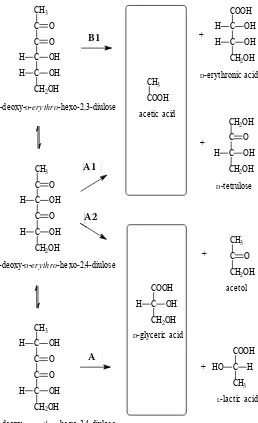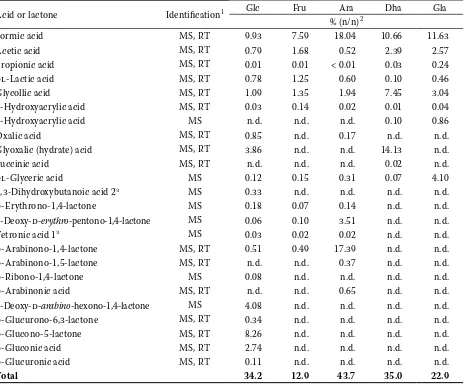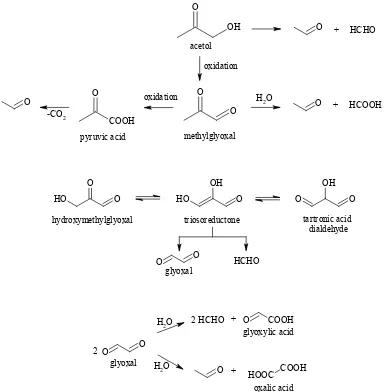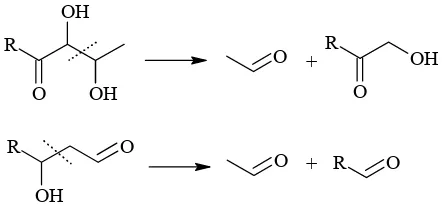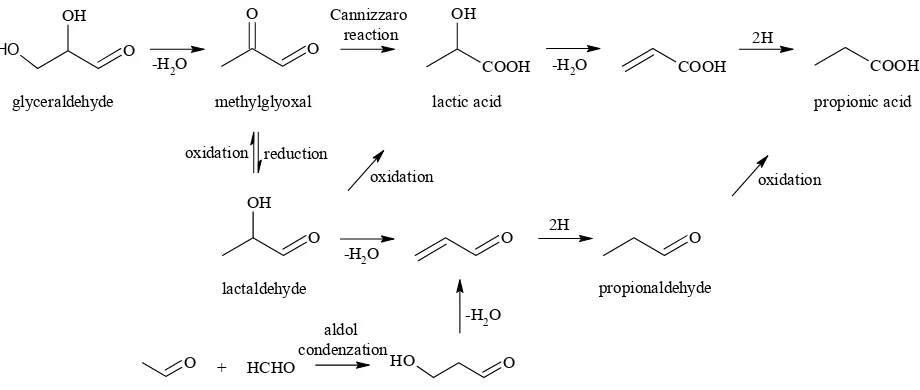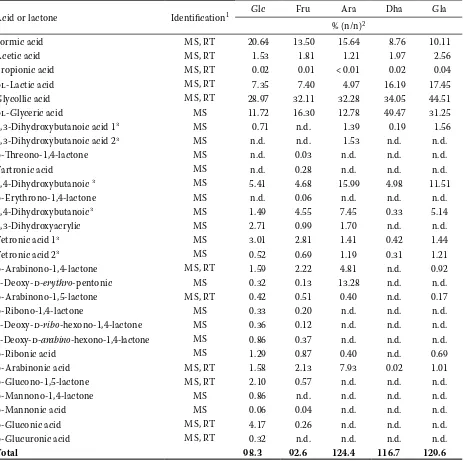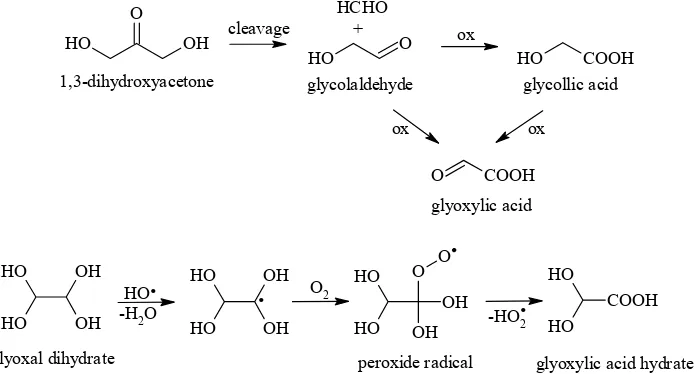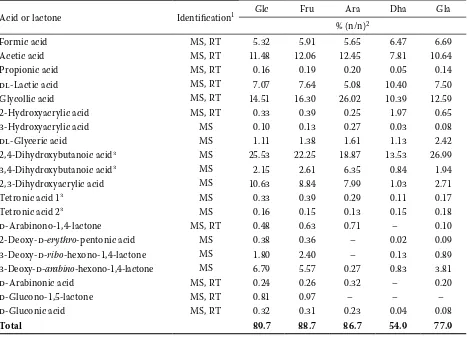Carboxylic and hydroxycarboxylic acids are an important family of products formed during oxida-tion of reducing sugars and/or carbonyls produced by their degradation. During thermal treatment of foods, the oxidation processes play an important role in the sugar transformations providing that either final oxidation products and/or key intermediates
undergo subsequent reactions (oxidative degrada-tion). The extent of sugar oxidation depends mainly on pH value, temperature, the type of sugar, and the presence and type of oxidising agents. Many papers reported on sugar oxidation proceeding under different conditions such as oxidation by enzymes (Geigert et al. 1983), free oxygen (Samuelson
Supported by the Ministry of Education, Youth and Sports of the Czech Republic (Projects COST 927, and MSM 6046137305).
Formation of Carboxylic Acids during Degradation
of Monosaccharides
Ondřej NOVOtNý, Karel CeJpeK and Jan VelíšeK
Department of Food Chemistry and Analysis, Faculty of Food and Biochemical
technology, Institute of Chemical technology in prague, prague, Czech Republic
Abstract
Novotný O., Cejpek K., Velíšek J. (2008): Formation of carboxylic acids during degradation of mono- saccharides.Czech J. Food Sci., 26: 117–131.
The formation of low molecular carboxylic and hydroxycarboxylic acids as well as sugar and deoxysugar acids from monosaccharides (d-glucose, d-fructose, d-arabinose, dl-glyceraldehyde, and 1,3-dihydroxyacetone) was studied in three different model systems: aqueous and alkaline solutions of potassium peroxodisulfate (K2S2O8), and sodium hydroxide solution. In total, 3 low molecular carboxylic acids (formic, acetic and propionic), 24 hydroxycarboxylic acids, and 12 corresponding lactones were identified and quantified by GC/MS. Formic, acetic, and propionic acids were isolated by extraction with diethyl ether and directly analysed by GC/MS; hydroxycarboxylic acids and their lactones were monitored as their trimethylsilylated derivatives using the same method. Formic, acetic, l-lactic, gly-collic, dl-2,4-dihydroxybutanoic acids and aldonic acids derived from the parent sugars were the most abundant compounds in all model systems. Within the models investigated, the yield of carboxylic acids and hydroxycarboxylic acids (together with their lactones) ranged between 9.3–22.2% (n/n) and between 3.6–116.9% (n/n), respectively. The amount of acids was significantly lower in aqueous solutions of K2S2O8 than in the alkaline solutions. The data ob-tained indicate that lower carboxylic acids are formed by both subsequent reactions (oxidation and/or intramolecular Cannizzaro reaction) of the sugar fragmentation products and direct decomposition of some intermediates such as uloses or hydroperoxides derived from the parent sugars. The acids possessing the original sugar skeleton are formed as a result of sugar oxidation or benzilic acid type rearrangement of deoxyuloses. Lower acids may also be formed by a recombination of free radicals.
& Thede 1968; Vuorinen 1985), hydrogen per-oxide (Isbell et al. 1973; Isbell & Frush 1973), or ozone (Marcq et al. 2001), pyrolysis (Hodge 1967; Ponder & Richards 1993), γ-irradiation (Kawakishi et al. 1975; Drijver & Holzapfel 1986), ultraviolet radiation (Phillips et al. 1964), or sonolysis (Heusinger 1988).
The acids produced during the sugar transforma-tion can be generally divided into those bearing the carbon skeleton of the parent sugar, and acids with a shorter carbon chains. Sugar-derived acids (i.e. aldonic, alduronic, aldaric, saccharinic, and ulonic acids) fall into the family of acids retain-ing the original carbon chain (or its part) of sugar. For example, gluconic and glucuronic acids, found in some Maillard model systems (Yaylayan & Huyghues-Despointes 1996), are well-known products formed by oxidation of aldehydic and/ or primary hydroxyl group of glucose, respec-tively. Saccharinic acids are typical products of transformation of sugars in strong alkaline me-dia, although their formation was observed also in acid media (Mizuno & Weiss 1974) and, to a minor extent, under high temperatures. They are formed by benzilic acid rearrangement of the corresponding deoxyuloses. Yang and Mont-gomery (1996b) identified several C4,C5, and C6-saccharinic acids formed during the degrada-tion of glucose and fructose in Ca(OH)2 solution. Ulosonic (2-keto) acids are formed via aldos-2-ulo- ses during, for example, oxidation of aldoses by HO• radicals (generated by the Fenton reagent, H2O2+Fe2+) (Davídek et al. 1990) or enzymatically (Geigert et al. 1983).
The acids having their carbon chain shorter than the parent sugar are formed either as direct cleavage products of sugar intermediates or by subsequent reactions of the carbonyl fragments formed. The sugar fragmentation leading directly to the acids via α- and β-dicarbonyl splitting was rather hypothetical for a long time. Considering the large number of citations in the literature, hy-drolytic α-dicarbonyl cleavage mechanism seems to be well-established. It has been repeatedly employed to explain the formation of acetic and formic acids by splitting of 1-deoxyhexo-2,3-di- uloses and 3-deoxyhexos-2-uloses, respectively (Figure 1) (Brands & van Boekel 2001). The same mechanism was proposed also for the formation of glyceric acid from 2-deoxyhexo-3,4-diulose (Yang & Montgomery 1996a). The splitting of β-dicarbonyl sugar intermediates was first pro-posed by Hayami (1961) and later confirmed by Weenen (1998), explaining the formation of acetol and glyceric acid from pentose and hexose sugars. The recent in-depth mechanistic study of Davídek et al. (2006a, b) employing labelled compounds (various 13C-labeled glucose isotopom-ers, 18O
2, H217O) represents a breakthrough in the understanding of the mechanisms involved in the acid formation. The experimental data obtained in this study showed coexistence of at least two reaction mechanisms leading to carboxylic acids, i.e. (i) hydrolytic β-dicarbonyl cleavage without intermediacy of any oxidising agent as the major pathway, and (ii) an alternative minor pathway via
[image:2.595.86.509.552.704.2]oxidative α-dicarbonyl cleavage induced by oxidis-ing species. Particularly, the reaction mechanisms
Figure 1. Hypothetical formation mechanism based on hydrolytic α-dicarbonyl cleavage of (A) 1-deoxy-d-erythro-he- xo-2,3-diulose and (B) 3-deoxy-d-erythro-hexos-2-ulose leading to acetic acid and formic acid, respectively (according to Ginz et al. 2000)
CH3 C C C C C H2 O H OH H OH O OH
1-deoxy-D-erythro-hexo-2,3-diulose
C H C CH2 C C C H2 O H OH H OH O OH
3-deoxy-D-erythro-hexos-2-ulose
H2O
OH -CH3 COOH C H C C C H2 H OH H OH O OH OH -acetic acid HCOOH A B + OH
-H2O OH
-+
erythrose 2-deoxy-D-arabinose
described (Figure 2) are involved in generating ace-tic acid (pathway A1) and d-glyceric acid (pathway A2) from 1-deoxy-d-erythro-hexo-2,4-diulose by hydrolytic β-dicarbonyl cleavage. Oxidative α-di-carbonyl cleavage is employed in the formation of couples of acetic/d-erythronic acid (pathway B1) and d-glyceric/l-lactic acid (pathway B2) from 1-deoxy-d-erythro-hexo-2,3-diulose and 1-deoxy-d-erythro-hexo-3,4-diulose, respectively.
Generally, it is assumed that low molecular hy-droxyacids are formed also consecutively from the corresponding hydroxycarbonyls and α-di-carbonyls by direct oxidation and intermolecular Cannizzaro reaction, respectively. For instance, the formation of glyceric acid was investigated during oxidation of glucose and fructose using 18O-enriched oxygen in alkaline solutions
(Vuo-rinen 1985). It was observed that glyceric acid is formed mainly by intramolecular Cannizzaro reaction from hydroxymethylglyoxal while only a small amount of this acid is produced by direct oxidation of glyceraldehyde.
While intermediacy of any oxidising agent is usu-ally not required for the formation of acetic acid, the development of formic acid is often linked with the decomposition of unstable oxidation products. The decomposition of 1- or 2-hydroperoxide gives rise to formic and lower aldonic acids (Vuorinen 1985), and the adduct of hydroperoxide anion to the aldehyde form of sugar provides formic acid and lower aldose (Isbell et al. 1973). It was found that aldohexoses are decomposed almost quantita-tively to 6 moles of formic acid while aldopentoses provide 5 moles of formic acid (per mol aldose) in
CH3 C C C C CH2OH
O O H H
OH OH
1-deoxy-D-erythro -hexo-2,3-diulose
CH3 C C C C CH2OH
O OH
H O OH H
1-deoxy-D-erythro -hexo-2,4-diulose
1-deoxy-D-erythro -hexo-3,4-diulose CH3
C C C C CH2OH
OH O
H O OH H
CH3 COOH
COOH C CH2OH
H OH
D-glyceric acid acetic acid
COOH C C CH2OH
OH OH H
H
CH2OH C C CH2OH
H OH
O
CH3 C CH2OH
O
COOH C CH3
HO H
D-erythronic acid
D-tetrulose
acetol
L-lactic acid +
+
+
+
B1
A1
A2
[image:3.595.71.329.326.749.2]B2
Figure 2. Scheme summarising possible pathways of sugar fragmentation via 1-deoxyhexodiulo-ses. A1 and A2, hydrolytic α-dicarbonyl clea-vage by nucleophilic attack of OH– at the C-2
and C-4 carbonyl groups, respectively. B1 and B2, oxidative β-dicarbonyl cleavage. Arrow thickness corresponds with the extent of reac-tion (adopted from Davídek et al. 2006b)
A1 B1
A2
aqueous alkaline solutions of hydrogen peroxide at 0°C (Isbell et al. 1973). Another alternative mecha-nism based on the recombination of free radicals (•CH3, •CH2-COOH, •COOH) was suggested for the formation of acetic acid and other mono- and dicarboxylic acids during the degradation of amino acids in K2S2O8 solutions (Rössner et al. 2001).
Recently, we reported on α-hydroxycarbonyl and α-dicarbonyl compounds formed during the degrada-tion of selected monosaccharides in model systems (Novotný et al. 2007). The work presented here is a continuation of our research on sugar degradation accomplished under the same experimental condi-tions employed previously. The objective of this part of study was to identify and quantify carboxylic acids formed in model systems and to elucidate the mechanisms leading to their formation.
MATERIAL AND METHODS
Chemicals. All following compounds were
obtained commercially: d-glucose, d-fructose (Sigma, St. Louis, USA), d-arabinose, 1,3-dihy-droxyacetone dimer, glycollic acid, glyoxylic acid hydrate, heptadecane (Fluka, Buchs, Switzerland), dl-glyceraldehyde (Reanal, Budapest, H), d-glu-cono-5-lactone, pyruvic acid, sodium d-gluconate,
N-trimethylsilylimidazole, N,O-bis(trimethylsilyl)- trifluoroacetamide (Aldrich, Steinheim, Germany), oxalic acid dihydrate, dl-lactic acid, potassium d-arabinate, l-malic acid, sodium d-glucuronate, succinic acid, sodium formate, sodium acetate trihydrate (Lachema, Brno, Czech Republic), propionic acid (Reachim, Russia), anhydrous so-dium sulfate, hydrochloric acid, soso-dium hydroxide (Penta, Chrudim, Czech Republic), diethyl ether, acetonitrile, N,N-dimethylformamide (Merck, Darmstadt, Germany), potassium peroxodisulfate (Dorapis, Prague, Czech Republic).
Degradation of sugars. Equimolar amounts of a sugar and potassium peroxodisulfate (5 mmol each) were dissolved in 50 ml of water or 0.3M sodium hydroxide, respectively (model 1 and model 2). The respective sugars (5 mmol) were also dissolved in 50 ml of 0.05M sodium hydroxide (model 3). All mixtures were heated under reflux for 1 h, then allowed to cool to room temperature and analysed for the contents of low molecular carbonyls. Three independent determinations were performed with each model system.
Quantification of formic, acetic and propionic acids.The cooled reaction mixture was adjusted
to pH 3.0 (except K2S2O8/H2O systems) with hy-drochloric acid (1M and 0.1M) and transferred to a separatory funnel. An aliquot of the diethyl ether stock solution of the internal standard (heptade-cane) was added and the mixture was extracted with four 20 ml portions of diethyl ether. Each extract was dried over anhydrous sodium sulfate. The combined extracts were concentrated to ap-proximately 1 ml and analysed by GC/MS. The quantification was performed by the method of calibration curve (5 points). Sodium formate, so-dium acetate (trihydrate), and propionic acid were used for the preparation of aqueous calibration solutions. After the addition of the internal stand-ard, the acids were isolated from the calibration solutions by the same procedure as described above. The following ions were used for quantification:
m/z 57 (heptadecane), m/z 46 (formic acid), m/z
43 (acetic acid), and m/z 74 (propionic acid).
Quantification of hydroxycarboxylic acids.An aliquot of each of the aqueous stock solution of the internal standard (l-malic acid) was added to 5 ml of cooled reaction mixture and the mixture was adjusted to pH 3.0 with hydrochloric acid (1M and 0.1M). A volume of 0.5 ml was evaporated to dryness and dissolved in 0.5 ml of the mixture of acetonitrile and N,N-dimethylformamide (1:1, v/v). Then 150 µl N-trimethylsilylimidazole and 150 µl
N,O-bis(trimethylsilyl)trifluoroacetamide were added, the mixture was treated in ultrasonic bath for 10 s, held for 10 min at 70°C, and analysed by GC/MS.The calibration curve method (5 points) was used for quantification. The calibration curves were measured for the following compounds: oxalic acid, glyoxylic acid hydrate, glycollic acid, pyruvic acid, succinic acid, dl-lactic acid, sodium d-glu-curonate, sodium d-gluconate, potassium d-ara-binate, and d-glucono-1,5-lactone. The standards of the acids and lactones were prepared in water with the addition of l-malic acid as the internal standard and derivatised as described previously. Only quantification of oxalic and pyruvic acids was performed using the characteristic ions m/z
190 and m/z 217, respectively; the other acids were quantified from total ion current record. Semi-quantification of those acids and lactones for which reference standards were not avail-able was accomplished using calibration curves obtained from structurally similar acids with the standards available.
acetic, and propionic acids, an Hewlett-Packard G1800A apparatus equipped with a fused silica capillary column CP WAX 52 CB (30 m × 0.25 mm i.d., film thickness of 0.25 µm) was used. The GC oven was temperature programmed from 60°C to 200°C (held 10 min) at the rate of 4°C, injector and detector temperatures were held at 220°C and 280°C, respectively. For the quantification of hydroxycarboxylic acids, an Agilent Technologies 6890N chromatograph with mass detector Agilent 5973N and a fused silica capillary column HP-5MS (30 m × 0.25 mm i.d., film thickness of 0.25 µm) was used. The GC oven was temperature programmed from 80°C (held 2 min) to 280°C (held 15 min) at the rate of 5°C, the injector and detector temperatures were held at 260°C and 280°C, respectively. Other parameters were the same for the analysis of both kinds of acids. The carrier gas (He) flow rate was 0.7 ml/min. The sample (1 µl) was injected using the split ratio 1:20. Mass spectra were obtained by EI ionisation at 70 eV and recorded in TIC mode. The ion source temperature was maintained at 250°C. The structural assignment of the com-pounds was accomplished using the Wiley275.L mass spectral computer library (Hewlett-Packard, Palo Alto, USA).
RESULTS AND DISCUSSION
The non-enzymatic degradation of sugars has been intensively studied for a long time, however, carboxylic acids formed by these reactions still lie apart from the main interest in spite of many important consequences related to their forma-tion being obvious. We studied the formaforma-tion of carboxylic and hydroxycarboxylic acids during the degradation of monosaccharides in three different model systems: aqueous solution of potassium peroxodisulfate (K2S2O8/H2O), alkaline solution of potassium peroxodisulfate (K2S2O8/0.3M NaOH), and alkaline sodium hydroxide solution (0.05M NaOH), respectively. The decomposition of per-oxodisulfate in aqueous solution provides several reactive species; hence peroxodisulfate represents simultaneously an oxidising agent, a radical initia-tor, and acidulant. It is well known that alkaline solutions cause deep changes in sugar molecule and certain similarity with the degradation of sug-ars under high temperatures is often considered. Recently, we identified several α-hydroxycarbonyl and α-dicarbonyl compounds formed in the systems mentioned above (Novotný et al. 2007). In the
present work, we extended our study to another group of products, carboxylic acids, to elucidate the main reaction pathways of sugar transforma-tions. The yields of acids identified in our reaction mixtures are given in Tables 1–3.
Formic, acetic, and propionic acids
Formic and acetic acids were the major acids identified in our reaction systems. The amounts of these acids differed considerably depending on the particular system and sugar employed (Tables 1–3).
Formic acid was present in large amounts in the reaction mixtures with K2S2O8/H2O (7.6–18.0%, n/n) and K2S2O8/0.3M NaOH (8.8–20.6%, n/n), and in a relatively small amount in 0.05M NaOH (5.3–6.7%, n/n), which implies several possible mechanisms of its formation. Formic acid is a well known by-product of many sugar degradation reactions. It is assumed that formic acid is formed by hydrolytic α-dicarbonyl cleavage of 3-deoxy-d-erythro-hexos-2-ulose (Figure 1B) (Brands & van Boekel 2001). Apparently, it can be formed by oxidation of formaldehyde by several oxida-tion reagents or in cross-Cannizzaro reacoxida-tion with simultaneous reduction of co-reactants. For-mic acid may be also a direct cleavage product of 1- or 2-hydroperoxides (primary products of sugar autoxidation) (Vuorinen 1985) and an aldose-hy-drogen peroxide adduct (Isbell et al. 1973). Both intermediates appear to be formed in the systems with peroxodisulfate where both triplet oxygen and hydrogen peroxide are available. Minor path-ways of formic acid formation in K2S2O8/H2O/he- xose models would be the decomposition of 5-hydroxymethylfuran-2-carbaldehyde in an acidic solution (Davídek et al. 1990) and, to a much smaller extent, an electrolytic ring opening of cyclic methylglyoxal dimer dihydrate regardless the model conditions (Huyghues-Despointes & Yaylayan 1996).
Acetic acid was detected as the major acid in 0.05M NaOH model systems, in which its amount (7.8–12.45%, n/n) was much higher than in K2S2O8/ 0.3M NaOH (1.2–2.6%, n/n) and K2S2O8/H2O (0.8–2.6%, n/n) systems. It was observed that the amount of acetic acid correlated well with the amounts of acetol and methylglyoxal (Novotný
forma-tion. Considering the literature data, it is evident that a significant portion of acetic acid can be formed by the direct fragmentation of the sugar skeleton. Davídek et al. (2006a) showed recently that hydrolytic β-dicarbonyl cleavage of 1-deoxy-hexo-2,4-diulose (Figure 2, pathway A1) is a major pathway of acetic acid formation, while oxidative α-dicarbonyl cleavage of 1-deoxy-d-erythro -hexo-2,3-diulose induced by some oxidising species is less frequent (Figure 2, pathway B1).
However, the results reported previously of kinet-ic studies (Brands & van Boekel 2001; Martins
[image:6.595.69.534.102.488.2]& van Boekel 2003) and labelling experiments (Kim & Baltes 1996; Ginz et al. 2000) pointed to hydrolytic α-dicarbonyl cleavage (Figure 1A) of 1-deoxy-d-erythro-hexo-2,3-diuloses as the predominant reaction pathway. Two papers re-ported on the incorporation of carbon atoms of glucose into acetic acid molecule in the binary system glucose/glycine. While Wnorowski and Yaylayan (2000) described the formation of acetic acid only from both ends of glucose in the ratio C-1/C-2 (~80%) and C-5/C-6 (~20%), Davídek et al. (2006a), for the first time, reported also minor
Table 1. Yields of acids and lactones in K2S2O8/H2O model systems
Acid or lactone Identification1 Glc Fru Ara Dha Gla
% (n/n)2
Formic acid MS, RT 9.93 7.59 18.04 10.66 11.63
Acetic acid MS, RT 0.79 1.68 0.52 2.39 2.57
Propionic acid MS, RT 0.01 0.01 < 0.01 0.03 0.24
dl-Lactic acid MS, RT 0.78 1.25 0.60 0.10 0.46
Glycollic acid MS, RT 1.09 1.35 1.94 7.45 3.04
2-Hydroxyacrylic acid MS, RT 0.03 0.14 0.02 0.01 0.04
3-Hydroxyacrylic acid MS n.d. n.d. n.d. 0.10 0.86
Oxalic acid MS, RT 0.85 n.d. 0.17 n.d. n.d.
Glyoxalic (hydrate) acid MS, RT 3.86 n.d. n.d. 14.13 n.d.
Succinic acid MS, RT n.d. n.d. n.d. 0.02 n.d.
dl-Glyceric acid MS 0.12 0.15 0.31 0.07 4.10
2,3-Dihydroxybutanoic acid 23 MS 0.33 n.d. n.d. n.d. n.d.
d-Erythrono-1,4-lactone MS 0.18 0.07 0.14 n.d. n.d.
2-Deoxy-d-erythro-pentono-1,4-lactone MS 0.06 0.10 3.51 n.d. n.d.
Tetronic acid 13 MS 0.03 0.02 0.02 n.d. n.d.
d-Arabinono-1,4-lactone MS, RT 0.51 0.49 17.39 n.d. n.d.
d-Arabinono-1,5-lactone MS, RT n.d. n.d. 0.37 n.d. n.d.
d-Ribono-1,4-lactone MS 0.08 n.d. n.d. n.d. n.d.
d-Arabinonic acid MS, RT n.d. n.d. 0.65 n.d. n.d.
2-Deoxy-d-arabino-hexono-1,4-lactone MS 4.08 n.d. n.d. n.d. n.d.
d-Glucurono-6,3-lactone MS, RT 0.34 n.d. n.d. n.d. n.d.
d-Glucono-5-lactone MS, RT 8.26 n.d. n.d. n.d. n.d.
d-Gluconic acid MS, RT 2.74 n.d. n.d. n.d. n.d.
d-Glucuronic acid MS, RT 0.11 n.d. n.d. n.d. n.d.
Total 34.2 12.9 43.7 35.0 22.9
1MS = identification by comparison with mass spectral library, RT = identification by comparison with retention
characte-ristics of authentic compounds
2Entries are averages of three independent determinations; RSD were < 20% within the whole experimental series, Glc =
d-glucose, Fru = d-fructose, Ara = d-arabinose, Dha = 1,3-dihydroxyacetone, Gla = dl-glyceraldehyde
3Compounds with unknown configuration of substituents; numerals correspond to diastereomers possessing identical MS
incorporation of C-3/C-4 carbon atoms. The fol-lowing distribution was found out in the study by Davídek et al. (2006a): C-1/C-2 (~70%), C-3/C-4 (~10%), and C-5/C-6 (~20%).
Analogously to formaldehyde, acetaldehyde can undergo oxidation by the available oxidants or in cross-Cannizzaro reaction. The mechanism based on the recombination of free radicals (Figure 5) was also suggested (Rössner et al. 2001). This pathway would be considered especially in systems with per-oxodisulfate where an extensive formation of free radicals is expected. Additionally, acetic acid may be produced also by hydrolytic dicarbonyl cleavage from the corresponding low molecular α- and/or β-dicarbonyls previously identified in the reaction mixtures (Novotný et al. 2007). Huyghues-Des- pointes and Yaylayan (1996) found acetic acid as the major (30%) product of methylglyoxal heated to 100°C. Thermal degradation (120°C, pH 6–10, up to
4 h) of pentane-2,4-dione and pentane-2,3-dione resulted in almost equimolar amounts of acetic acid and acetone as well as acetic acid and propionic acid, respectively (Davídek et al. 2006a).
Propionic acid was detected in negligible amounts in all the reaction mixtures investigated. Generally, larger amount of this acid were found in 0.05M NaOH models (0.05–0.20%, n/n), but the largest proportional amount (0.24%, n/n) was detected in glyceraldehyde/K2S2O8/H2O system. Mark-edly, larger amounts of propionic acid quantified in mixtures containing glyceraldehyde pointed to this aldehyde being an important precursor. We predicted a stepwise mechanism(Figure 6) considering lactic acid and lactaldehyde as the key intermediates. Lactic acid could be formed either by Cannizzaroreaction from methylglyoxal (product of glyceraldehyde dehydration) or by oxidation of lactaldehyde. Lactic acid may undergo
OH O
acetol
O
O O
pyruvic acid COOH O
HCOOH +
O oxidation
oxidation
tartronic acid dialdehyde
H2O
-CO2 O
2 HCHO
+
O O O H
methylglyoxal
O OH O H
hydroxymethylglyoxal
O OH O
oxalic acid
HCHO
O O
H2O
H2O
HCHO
O COOH
+
O HOOC COOH
+ triosoreductone
glyoxal
glyoxylic acid
O O
[image:7.595.92.477.343.735.2]glyoxal 2
dehydration followed by the acceptance of two hydrogen atoms (by reaction with some hydride donors such as glycolaldehyde) which gives rise to propionic acid. Analogously, lactaldehyde pro-duces propionaldehyde, which is finally oxidised to propionic acid. The formation of prop-2-enal, the key intermediate of propionaldehyde, would also proceed hypothetically by aldol condensa-tion of acetaldehyde and formaldehyde (Figure 6). An alternative reaction pathway leading to the formation of propionic acid represents oxidative α-dicarbonyl cleavage of pentane-2,3-dione pro-viding acetic acid as a counterpart (Davídek et al. 2006a). Theoretically, propionic acid may be also formed by the recombination of free radicals (Rössner et al. 2001) (Figure 5).
Formaldehyde and acetaldehyde
The presence of the above mentioned inter-mediates, formaldehyde and acetaldehyde, was observed in all reaction mixtures; nevertheless, their yields were not determined. Both aldehydes were identified as condensation products with
o-phenylendiamine (OPDA) used for derivatisation of α-dicarbonyl compounds (Novotný et al. 2007).
(1H)-Benzimidazole and 2-methyl-(1H) -benzimi-dazole were identified as the OPDA condensation products of formaldehyde and acetaldehyde, re-spectively. Using authentic standards, we observed that both aldehydes can subsequently undergo a second addition to the already formed
benzimi-dazoles including also cross-addition (addition of one aldehyde to the benzimidazole arosen from the other aldehyde). Owing to these findings, we could not use this procedure for quantification.
Formaldehyde is the simplest fragment of sug-ars. Its formation was confirmed in many studies concerning sugar degradation. Its scission from 1-endiols yields lower aldose as the second prod-uct. Formaldehyde was also suggested as a product of cleavage of C1–C2 bond of the acyclic adduct of hydroperoxide anion to ketoses (Isbell et al.
1973). Acetaldehydecould hypothetically arise by retro-aldol cleavage of intermediates having structure motives of 1-deoxy-2,3-dihydroxy-4-oxo or 2-deoxy-3-hydroxy-1-oxo (Figure 4). In fact, no report introducing any certain six or five carbon precursor with this structure motive is available. However, both aldehydes are known to be scission products of some lower carbonyls (Figure 3). For example, cleavage of triosoreductone provides for-maldehyde and glyoxal, while scission of 1-en-1,2-diol of acetol gives formaldehyde and acetaldehyde (Velíšek 2002). Rössner (2004) predicted the formation of both aldehydes during the cleavage of glyoxal and subsequent disproportionation of the fragments formed. Analogously, acetaldehyde and formaldehyde could also form from methyl-glyoxal with simultaneous formation of the cor-responding acid. Furthermore, pyruvic acid may be formed by oxidation of methylglyoxal and can consecutively decarboxylate yielding acetaldehyde. The identification of pyruvic acid in our model systems supports this reaction pathway.
Hydroxyacids and lactones
In total, 24 hydroxycarboxylic acids and 12 cor-responding lactones were identified and quantified in all model systems after derivatisation (Tables 1–3).
Basically, the acids identified in our model sys-tems can be divided into two groups: (i) acids possessing the original carbon skeleton of the parent sugar and (ii) acids with a shorter carbon
OH
OH R
O
O
+
OH R
O
O R
OH
O +
R O
intermediates and products of sugar degradation
COOH
COOH
HOOC COOH
acetic acid propionic acid
butyric acid
succinic acid
.
CH3.
CH2 COOH.
COOH [image:8.595.68.289.91.194.2]CH3COOH
Figure 4. Acetaldehyde formation by retro-aldol cleavage
chain. Direct oxidation of sugar aldehydic group and primary hydroxyl group, respectively, and benzilic acid type rearrangement of deoxyuloses are the possible routes involved in the formation of the first group of acids, i.e. aldonic, alduronic, and saccharinic acids. The data obtained confirmed that benzilic acid type rearrangement was signifi-cantly enhanced in alkaline media, nevertheless, this rearrangement proceeded to some extent also in acidic medium (K2S2O8/H2O system). Obviously, water acting as the Brønsted base remains an ef-fective catalyst for the rearrangement reaction in this case (Antal et al. 1990).
Acids of the second group with a shorter carbon chains are either direct cleavage products of the corresponding intermediates or oxidation prod-ucts of low-molecular carbonyls arising primarily by sugar fragmentation. Comparing, the spectra of the acids and carbonyl compounds, previously identified in the same models (Novotný et al.
2007), it is evident that the formation of many acids is linked with direct oxidation of α-hydroxy-carbonyl compounds as well as with α-diα-hydroxy-carbonyl compounds transformed via Cannizzaro reaction. Understandably, the yield of acids in particular model system increases as follows: K2S2O8/H2O < 0.05M NaOH < K2S2O8/0.3M NaOH. The extent of oxidation is significantly enhanced in alkaline media due to extensive enolisation. However, the majority of the identified acids retain the configu-ration of the parent sugar (arabino-, erythro-), but acids with different configurations were also found. The change of configuration is caused either by the previous isomerisation of the sugar precursor
or by the formation from lower intermediates via
aldolisation.
It is well known that sugar acids readily undergo lactonisation to form relatively stable 4-lactones andless stable 5-lactones. Thus, the free form of acid and at least one lactone were mostly identified. Both Cannizzaro reaction and benzilic acid type rearrangement result in the formation of racemic mixtures of acids. Under chromatographic con-ditions used, it was not possible to separate the individual acids from their diastereomeric pairs.
C2 acids
Glycollic, oxalic, and glyoxylic acids represent two-carbon chain hydroxyacids identified in our model systems. Glycollic (hydroxyacetic) acid was the major acid almost in all mixtures studied. Gly-collic acid is a direct oxidation product of glycol- aldehyde but, obviously, it is predominantly formed from glyoxal via the intermolecular Cannizzaro reaction. The formation of glycollic acid was also observed after the cleavage of the reaction product of hydrogen peroxide with hydroxymethylglyoxal (Vuorinen 1985) and ketoses (Isbell & Frush 1973). In the arabinose mixtures, glycollic acid can be also produced either by hydrolytic β-dicarbonyl cleavage of 1-deoxypento-2,4-diulose or by oxida-tive α-dicarbonyl cleavage of 1-deoxypento-3,4-di- ulose (Davídek et al. 2006a, b).
Oxalic (ethanedioic) acid was present in meas-urable amounts only in two K2S2O8/H2O reaction mixtures (glucose and fructose). In fact, oxalic acid could be formed either by oxidation of both O
OH O
H
reduction
-H2O O O
lactaldehyde O OH glyceraldehyde
oxidation
COOH OH
methylglyoxal
propionaldehyde -H2O
Cannizzaro reaction
2H
COOH
-H2O COOH
lactic acid
O
2H
O
O + HCHO aldol condenzation
O O
H -H2O
propionic acid
[image:9.595.68.528.83.278.2]oxidation oxidation
carbonyl groups of glyoxal or by oxidation of hy-droxyl group of glycollic acid. Rössner (2004) also assumed that oxalic acid is produced by the cleav-age of glyoxal and subsequent disproportionation of the fragments formed (Figure 3).
Glyoxylic (oxoacetic) acid identified in the form of its hydrate was found only in the mixtures of
glu-cose and 1,3-dihydroxyacetone in the K2S2O8/H2O system, but interestingly in significant amounts. Apparently, its high level (14.13%, n/n) is linked with the high content of glycollic acid (7.45%, n/n) as well as of glycolaldehyde (4.70%, n/n), as previously reported (Novotný et al. 2007). This fact unequivocally pointed to a stepwise
mecha-Table 2. Yields of acids and lactones in K2S2O8/0.3M NaOH model systems
Acid or lactone Identification1 Glc Fru Ara Dha Gla
% (n/n)2
Formic acid MS, RT 20.64 13.50 15.64 8.76 10.11
Acetic acid MS, RT 1.53 1.81 1.21 1.97 2.56
Propionic acid MS, RT 0.02 0.01 < 0.01 0.02 0.04
dl-Lactic acid MS, RT 7.35 7.40 4.97 16.19 17.45
Glycollic acid MS, RT 28.97 32.11 32.28 34.05 44.51
dl-Glyceric acid MS 11.72 16.30 12.78 49.47 31.25
2,3-Dihydroxybutanoic acid 13 MS 0.71 n.d. 1.39 0.19 1.56
2,3-Dihydroxybutanoic acid 23 MS n.d. n.d. 1.53 n.d. n.d.
d-Threono-1,4-lactone MS n.d. 0.03 n.d. n.d. n.d.
Tartronic acid MS n.d. 0.28 n.d. n.d. n.d.
2,4-Dihydroxybutanoic 3 MS 5.41 4.68 15.99 4.98 11.51
d-Erythrono-1,4-lactone MS n.d. 0.06 n.d. n.d. n.d.
3,4-Dihydroxybutanoic3 MS 1.49 4.55 7.45 0.33 5.14
2,3-Dihydroxyacrylic MS 2.71 0.99 1.70 n.d. n.d.
Tetronic acid 13 MS 3.01 2.81 1.41 0.42 1.44
Tetronic acid 23 MS 0.52 0.69 1.19 0.31 1.21
d-Arabinono-1,4-lactone MS, RT 1.59 2.22 4.81 n.d. 0.92
2-Deoxy-d-erythro-pentonic MS 0.32 0.13 13.28 n.d. n.d.
d-Arabinono-1,5-lactone MS, RT 0.42 0.51 0.40 n.d. 0.17
d-Ribono-1,4-lactone MS 0.33 0.20 n.d. n.d. n.d.
3-Deoxy-d-ribo-hexono-1,4-lactone MS 0.36 0.12 n.d. n.d. n.d.
3-Deoxy-d-arabino-hexono-1,4-lactone MS 0.86 0.37 n.d. n.d. n.d.
d-Ribonic acid MS 1.29 0.87 0.40 n.d. 0.69
d-Arabinonic acid MS, RT 1.58 2.13 7.93 0.02 1.01
d-Glucono-1,5-lactone MS, RT 2.10 0.57 n.d. n.d. n.d.
d-Mannono-1,4-lactone MS 0.86 n.d. n.d. n.d. n.d.
d-Mannonic acid MS 0.06 0.04 n.d. n.d. n.d.
d-Gluconic acid MS, RT 4.17 0.26 n.d. n.d. n.d.
d-Glucuronic acid MS, RT 0.32 n.d. n.d. n.d. n.d.
Total 98.3 92.6 124.4 116.7 129.6
1MS = identification by comparison with mass spectral library, RT = identification by comparison with retention
characte-ristics of authentic compounds
2Entries are averages of three independent determinations; RSD were < 20% within the whole experimental series, Glc =
d-glucose, Fru = d-fructose, Ara = d-arabinose, Dha = 1,3-dihydroxyacetone, Gla = dl-glyceraldehyde
3Compounds with unknown configuration of substituents; numerals correspond to diastereomers possessing identical MS
[image:10.595.69.533.102.563.2]nism (Figure 7) which starts with the cleavage of 1,3-dihydroxyacetone providing glycolaldehyde and formaldehyde. The consequent oxidation of glycolaldehyde can hypothetically proceed in two ways: (i) oxidation of carbonyl group to form gly-collic acid followed by oxidation of hydroxy group giving rise to glyoxylic acid, and/or (ii) direct oxidation of hydroxy group of glycolaldehyde. Considering the high content of glycollic acid, it is obvious that oxidation via this acid is the major reaction. The formation of glyoxylic acid is supposed to proceed also after the cleavage of glyoxal and subsequent disproportionation of the fragments formed (Figure 3) (Rössner 2004). Direct formation of glyoxylic acid hydrate is as-sumed to be the result of autoxidation of glyoxal dihydrate (Buxton et al. 1997) initiated by free radicals (Figure 7).
C3 acids
Lactic, glyceric, pyruvic, tartronic, and 2,3-dihy-droxyacrylic acids are three-carbon hydroxyacids identified in the investigated reaction mixtures.
Lactic (2-hydroxypropanoic) acid was found in large amounts in alkaline reaction mixtures indicat-ing its predominant formation via intramolecular Cannizzaro reaction of methylglyoxal. Another possible way is direct oxidation of lactaldehyde. The formation of l-lactic acid in pentose and hexose mixtures can also be explained by oxida-tive α-dicarbonyl cleavage of 1-deoxy-3,4-diuloses providing d-glyceric acid (hexoses) and glycollic acid (pentoses) as the counterparts (for hexoses Figure 2, pathway B2) (Davídek et al. 2006b).
Glyceric (2,3-dihydroxypropanoic) acid was found in all mixtures studied with the largest amount quantified in K2S2O8/0.3M NaOH sys-tems. The highest yields of this acid were found in the reaction mixtures of glyceraldehyde; it is obvious that glyceric acid is formed mainly by direct oxidation of glyceraldehyde. Neverthe-less, significant amounts of this acid can be also produced by intermolecular Cannizzaro reac-tion of hydroxymethylglyoxal (Vuorinen 1985). In mixtures containing hexoses, d-glyceric acid may be formed also as a direct cleavage product of the corresponding intermediates (Davídek et al. 2006a, b). Moreover, α- and β-splitting pro-viding glyceric acid was previously proposed for 2-deoxyhexo-3,4-diulose (Yang & Montgomery 1996a) and 1-deoxyhexo-2,4-diulose (Weenen 1998), respectively.
Two other compounds identified, i.e. 2- and 3-hydroxyacrylic (2- and 3-hydroxyprop-2-enoic) acids are evidently isomers of pyruvic (2-oxo-propionic) acid. We have found that silylation of pyruvic acid is linked with isomerisation because only 2-hydroxyacrylic acid was obtained after derivatisation of authentic pyruvic acid. Since no 3-hydroxyacrylic acid was found after silylation of pyruvic acid, it is obvious that its formation is not linked with derivatisation procedure and can be understood as a result of isomerisation proceeding during the model experiment. 2-Hydroxyacrylic and 3-hydroxyacrylic acids belonged to minor reaction products in all models. Pyruvic acid is apparently formed by oxidation of methylglyoxal, but this re-action is, in comparison with Cannizzaro rere-action, markedly less frequent. Considering the origin of
glycolaldehyde OH
O O
H cleavage
O
H O
+ HCHO
O
H COOH
O COOH
1,3-dihydroxyacetone glycollic acid
glyoxylic acid hydrate ox
ox
ox
OH OH O
H
O
H COOH
O H
O H glyoxylic acid
O2 -H2O
glyoxal dihydrate peroxide radical
OH OH O
H
O H
.
-HO2
.
.
HO HO
O
H OH
OH O O
.
[image:11.595.72.419.568.755.2]pyruvic acid via some C5 or C6 precursors, it should be an intermediate with the structure motive of 1-deoxy-hexo(pento)-2,3,4-triulose.
Tartronic (2-hydroxypropanedioic) acid was identified only in the fructose/K2S2O8/0.3M NaOH model. Apparently, it is formed by oxidation of the corresponding aldehyde which arises by isomeri-sation of hydroxymethylglyoxal.
2,3-Dihydroxyacrylic (2,3-dihydroxyprop-2-enoic)acid is an uncommon acid identified only in alkaline reaction mixtures. It seems probable that the corresponding dialdehyde is its imme-diate precursor. In theory, the probable way of the formation of such an aldehyde is retro-aldol cleavage of 2-endiol form of 2-ulose having at least four carbon atoms. Oxidation of C1–C2 bond of
glyceric acid possibly leads to the formation of 2,3-dihydroxyacrylic acid from trioses.
C4 and C5 acids
Succinic acid, aldonic acids, and different types of saccharinic acids with four- and five-carbon atoms were detected in our model systems.
[image:12.595.65.534.102.440.2]Succinic (butanedioic) acidwas found in neg-ligible amounts only in the 1,3-dihydroxyace-tone/K2S2O8/H2O system. This acid is obviously formed from lower intermediates. For example, the corresponding 2-en-dialdehyde can arise from acetaldehyde and glyoxal by aldol condensation; this intermediate can provide succinic acid in re-dox reactions. Succinic acid can be also formed by
Table 3. Yields of acids and lactones in 0.05M NaOH model systems
Acid or lactone Identification1 Glc Fru Ara Dha Gla
% (n/n)2
Formic acid MS, RT 5.32 5.91 5.65 6.47 6.69
Acetic acid MS, RT 11.48 12.06 12.45 7.81 10.64
Propionic acid MS, RT 0.16 0.19 0.20 0.05 0.14
dl-Lactic acid MS, RT 7.07 7.64 5.08 10.40 7.50
Glycollic acid MS, RT 14.51 16.30 26.02 10.39 12.59
2-Hydroxyacrylic acid MS, RT 0.33 0.39 0.25 1.97 0.65
3-Hydroxyacrylic acid MS 0.10 0.13 0.27 0.03 0.08
dl-Glyceric acid MS 1.11 1.38 1.61 1.13 2.42
2,4-Dihydroxybutanoic acid3 MS 25.53 22.25 18.87 13.53 26.99
3,4-Dihydroxybutanoic acid3 MS 2.15 2.61 6.35 0.84 1.94
2,3-Dihydroxyacrylic acid MS 10.63 8.84 7.99 1.03 2.71
Tetronic acid 13 MS 0.33 0.39 0.29 0.11 0.17
Tetronic acid 23 MS 0.16 0.15 0.13 0.15 0.18
d-Arabinono-1,4-lactone MS, RT 0.48 0.63 0.71 – 0.10
2-Deoxy-d-erythro-pentonic acid MS 0.38 0.36 – 0.02 0.09
3-Deoxy-d-ribo-hexono-1,4-lactone MS 1.80 2.40 – 0.13 0.89
3-Deoxy-d-arabino-hexono-1,4-lactone MS 6.79 5.57 0.27 0.83 3.81
d-Arabinonic acid MS, RT 0.24 0.26 0.32 – 0.20
d-Glucono-1,5-lactone MS, RT 0.81 0.97 – – –
d-Gluconic acid MS, RT 0.32 0.31 0.23 0.04 0.08
Total 89.7 88.7 86.7 54.9 77.9
1MS = identification by comparison with mass spectral library, RT = identification by comparison with retention
characte-ristics of authentic compounds
2Entries are averages of three independent determinations; RSD were < 20% within the whole experimental series, Glc =
d-glucose, Fru = d-fructose, Ara = d-arabinose, Dha = 1,3-dihydroxyacetone, Gla = dl-glyceraldehyde
3Compounds with unknown configuration of substituents; numerals correspond to diastereomers possessing identical MS
recombination of free radicals(Figure 5) (Rössner
et al. 2001).
Two isomers ofd-tetronic acidhaving erythro- and
threo-configuration were found, but they were not differentiated because they possessed identical MS spectra. In addition, the corresponding lactones, d-threono-4-lactone and d-erythrono-4-lactone, were found in some mixtures. Similarly, d-arabi-nonic and d-ribonic acids were found in reaction mixtures together with their 4-lactones. Basically, several mechanisms can be involved in the forma-tion of lower aldonic acids. The first one is based on direct oxidation of lower aldose which can be formed from the parent sugar by retro-aldol scis-sion. Ruff degradation (decarboxylation of aldonic or alduronic acids) (Isbell & Salam 1981; Marcq
et al. 2001) or decomposition of acyclic peroxide adduct (Isbell et al. 1973) represent pathways pro-viding lower aldoses as well. The direct formation of lower aldonic acids by decomposition of unstable 1- and 2-hydroperoxides with the simultaneous production of formic acid is assumed to be also involved during sugar oxidation (Davídek et al.
1990). Moreover, the recently described mechanism based on oxidative α-dicarbonyl cleavage of 1-de-oxy-d-erythro-hexo-2,3-diulose (Figure 2, pathway B1) (Davídek et al. 2006b) may be also considered for the formation of a certain portion of C4-aldonic acid with acetic acid as a counterpart.
In total, 3 types of saccharinic acid with four-carbon atoms (2-deoxy-, 3-deoxy- and 4-deoxy- tetronic) were identified. 2,3-Dihydroxybutanoic (4-deoxytetronic) acid was found in two isomeric forms possessing erythro- and threo-configuration, respectively. It was not possible to differentiate them using the mass spectra measured. This acid is probably formed via intramolecular Cannizzaro reaction from the corresponding 4-deoxytetros-2-ulose. 2,4-Dihydroxybutanoic (3-deoxytetronic) acid was eluted only as one peak corresponding probably to both isomeric forms. The precursor of this metasaccharinic acid is the corresponding 3-deoxytetros-2-ulose. The last deoxytetronic acid, 3,4-dihydroxybutanoic (2-deoxytetronic) acid, yielded also a single peak. It was probably formed from 3-deoxypentos-2-ulose by α-diketo cleavage with formaldehyde produced as a by-product (Yang & Montgomery 1996b). 2-Deoxy-d-erythro -pen-tonic acid (identified also as the corresponding 1,4-lactone) represents the only one five-carbon chain of deoxyacid found. Its formation is analo-gous to that of its lower homologue.
C6 acids
Aldonic, alduronic, and deoxyaldonic acids and the corresponding lactones containing six carbon atoms were identified, mainly in models containing hexoses and, to some extent, also in models with pentoses and trioses. The presence of C6 acids in the mixtures of lower sugars indicates previous aldolisation of lower carbonyl intermediates.
No free forms of deoxyhexonic acids were found; only three lactones, i.e. 3-deoxy-d-arabi- no-hexono-1,4-lactone and isomeric 3-deoxy-d-ri- bo-hexono-1,4-lactone, and 2-deoxy-d-arabino -hexono-1,4-lactone were identified. The formation of 3-deoxyhexonic acid corresponding to the first two lactones proceeds obviously via benzilic acid type rearrangement of 3-deoxy-d-erythro -hexos-2-ulose. We have found out that the diastereo- meric pair of metasaccharinic acids (occurring as lactones) is not produced in equimolar ratio. The lactone possessing arabino-configuration was present usually in amounts 2–3 times larger than that possessing ribo-configuration. It indicates that different reaction pathways independent on benzilic acid type rearrangement are involved in their formation. Similarly, it is difficult to explain the formation of 2-deoxy-d-arabino-hexonic acid. It may be understood as a result of specific oxida-tion and cleavage of certain uloses having seven carbon atoms which can be formed by aldol con-densation of lower intermediates.
CONCLUSION
The data obtained have shown that the degrada-tion of sugars yields a wide spectrum of various carboxylic acids under the experimental conditions used. Furthermore, carboxylic acids were the major sugar transformation products. Contrary to the low molecular weight carbonyls described previously, acids can be assessed as the final reaction products. Low molecular weight acids were largely formed by oxidation and/or intermolecular Cannizzaro reaction of low molecular carbonyl intermediates, and/or by direct cleavage of 1-deoxydiuloses de-rived from the parent sugars. The acids possessing the original sugar chain were either the result of direct sugar oxidation (aldonic or alduronic acids) or benzilic acid type rearrangement of deoxyuloses (saccharinic acids). Obviously, the degradation proceeded via decomposition of unstable interme-diates such as hydroperoxides or peroxide adducts which also took part in the formation of lower aldonic and formic acids. In addition, alternative mechanisms based on the recombination of free radicals should also be considered in the forma-tion of some lower acids.
References
Antal M.J. Jr., Mok W.S.L., Richards G.N. (1990): Four-carbon model compounds for the reactions of sugars in water at high temperature. Carbohydrate Research, 199: 111–115.
Belitz H.D., Grosch W. (1999): In: Food Chemistry, 2nd Ed.Springer-Verlag, Berlin, Heidelberg.
Brands C.M.J., van Boekel M.A.J.S. (2001): Reaction of monosaccharides during heating of sugar-casein system: Building of reaction network model. Journal of Agricultural and Food Chemistry, 49: 4667–4675. Buxton G.V., Malone T.N., Salmon G.A. (1997):
Oxidation of glyoxal initiated by •OH in oxygenated aqueous solution. Journal of the Chemical Society, Faraday Transactions, 93:2889–2891.
Davídek J., Velíšek J., Pokorný J. (eds) (1990): Chemi-cal Changes during Food Processing. Developments in Food Science Vol. 21. Elsevier Science Publishers, Amsterdam.
Davídek T., Devaud S., Robert F., Blank I. (2006a): Sugar fragmentation in the Maillard reaction cascade: isotope labelling studies on the formation of acetic acid by a hydrolytic β-dicarbonyl cleavage mecha-nism. Journal of Agricultural and Food Chemistry, 54: 6667–6676.
Davídek T., Robert F., Devaud S., Vera F.A., Blank I. (2006b): Sugar fragmentation in the Maillard reaction cascade: Formation of short-chain carboxylic acids by a new oxidative α-dicarbonyl cleavage pathway. Journal of Agricultural and Food Chemistry, 54: 6677–6684. Drijver L. den, Holzapfel C.W. (1986): Separation and
quantitative determination of the radiolysis products of d-fructose as their O-benzyloximes. Journal of Chromatography A, 363: 345–352.
Geigert J., Neidleman S.L., Hirano D.S., Wolf B., Panschar B.M. (1983): Enzymic oxidation of d-ara- bino-hexos-2-ulose (d-glucosone) to d-arabino -2-hexu-losonic acid (“2-keto-d-gluconic acid”). Carbohydrate Research, 113:163–165.
Ginz M., Balzer H.H., Bradbury A.G.W., Maier H.G. (2000): Formation of aliphatic acids by carbohydrate degradation during roasting of coffee. European Food Research & Technology, 211: 404–410.
Hayami J. (1961): Studies on the chemical decomposition of simple sugars. XII. Mechanism of acetol forma-tion. Bulletin of the Chemical Society of Japan, 34: 927–932.
Heusinger H. (1988): Action of ultrasound on deoxy-genated aqueous solutions of d-glucose. Carbohydrate Research, 181: 67–75.
Hodge J.E. (1967): Origin of flavor in foods. Non-en-zymatic browning reactions. In: Schultz H.W., Day E.A., Libbey L.M. (eds): Chemistry and Physiology of Flavors. AVI Publishing, Westport: 465–491.
Huyghues-Despointes A., Yaylayan V.A. (1996): Retro-aldol and redox reactions of Amadori com-pounds: Mechanistic studies with variously labeled d-[13C]glucose. Journal of Agricultural and Food
Chem-istry, 44: 672–681.
Isbell H.S., Frush H.L. (1973): Reaction of carbohydrates with hydroperoxides. Part II. Oxidation of ketoses with the hydroperoxide anion. Carbohydrate Research, 28: 295–301.
Isbell H.S., Frush H.L., Martin E.T. (1973): Reaction of carbohydrates with hydroperoxides, Part I. Oxida-tion of aldoses with sodium peroxide. Carbohydrydrate Research, 26: 287–295.
Isbell H.S., Salam M.A. (1981): Degradation of calcium d-gluconate-2-d with alkaline hydrogen peroxide. Carbohydrate Research, 90: 123–126.
Kawakishi S., Kito Y., Namiki M. (1975): γ-Radiolysis of d-glucose in aerated, aqueous solution. Carbohydrate Research, 39:263–269.
Marcq O., Barbe J.-M., Trichet A., Guilard R. (2001): Origin and significance of the production of carbon dioxide during the ozonization of 13C-labeled
d-glu-cose at different pH values. Carbohydrate Research, 333: 233–240.
Martins S.I.F.S., van Boekel M.A.J.S. (2003): Kinetics modeling of Amadori N-(1-deoxy-d-fructos-1-yl)glycine degradation pathways. Part I – Reaction mechanism. Carbohydrate Research, 338: 1651–1663.
Mizuno T., Weiss A.H. (1974): Synthesis and utiliza-tion of formose sugars. Advances in Carbohydrate Chemistry and Biochemistry, 29: 173–227.
Novotný O., Cejpek K., Velíšek J. (2007): Formation of α-hydroxycarbonyl and α-dicarbonyl compounds during degradation of monosaccharides.Czech Journal of Food Sciences, 25: 119–130.
Phillips G.O., Barber P., Rickards T. (1964): Pho-to-degradation of carbohydrates. Part III Sensitized photo-oxidation of d-sorbitol. Journal of the Chemical Society: 3443–3450.
Ponder G.R., Richards G.N. (1993): Pyrolysis of inulin, glucose, and fructose. Carbohydrate Research, 244: 341–359.
Rössner J., Velíšek J., Pudil F., Davídek J. (2001): Strecker degradation products of aspartic and glutamic acids and their amides.Czech Journal of Food Sci-ences, 19: 41–45.
Rössner J. (2004): Aromatické látky vznikající v Mail-lardově reakci. [Disertační práce.] Vysoká škola che-micko-technologická v Praze: 53–54.
Samuelson O., Thede L. (1968): Influence of oxygen upon glucose and cellobiose in strongly alkaline me-dium. Acta Chemica Scandinavica, 22:1913–1923. Velíšek J. (2002): Chemie potravin, část I. 2. vydání.
Ossis, Tábor: 270.
Vuorinen T. (1985): Cleavage of the intermediate hydroperoxides in the oxidation of d-glucose and d-fructose with oxygen. Carbohydrate Research, 141: 319–322.
Weenen H. (1998): Reactive intermediates and carbo-hydrate fragmentation in Maillard chemistry. Food Chemistry, 62: 393–401.
Wnorowski A., Yaylayan V.A. (2000): Influence of pyrolytic and aqueous-phase reactions on the mecha-nism of formation of Maillard products. Journal of Agricultural and Food Chemistry, 48: 3549–3554. Yaylayan V.A., Huyghues-Despointes A. (1996):
Identification of per-O-(trimethylsilyl) derivates of aldoses generated from thermal decomposition of
N-(1-deoxy-d-fructopyranos-1-yl)proline: reversibility of the Amadori rearrangement. Carbohydrate Research, 286: 179–187.
Yang Y.B., Montgomery R. (1996a): Alkaline degra-dation of glucose: effect of initial concentration of reactants. Carbohydrate Research, 280: 27–45. Yang Y.B., Montgomery R. (1996b): Alkaline
degra-dation of fructofuranosides. Carbohydrate Research, 280: 47–57.
Received for publication January 30, 2007 Accepted after corrections April 2, 2007
Corresponding author:
Prof. Ing. Jan Velíšek, DrSc., Vysoká škola chemicko-technologická v Praze, Fakulta potravinářské a biochemické technologie, Ústav chemie a analýzy potravin, Technická 5, 166 28 Praha 6, Česká republika
